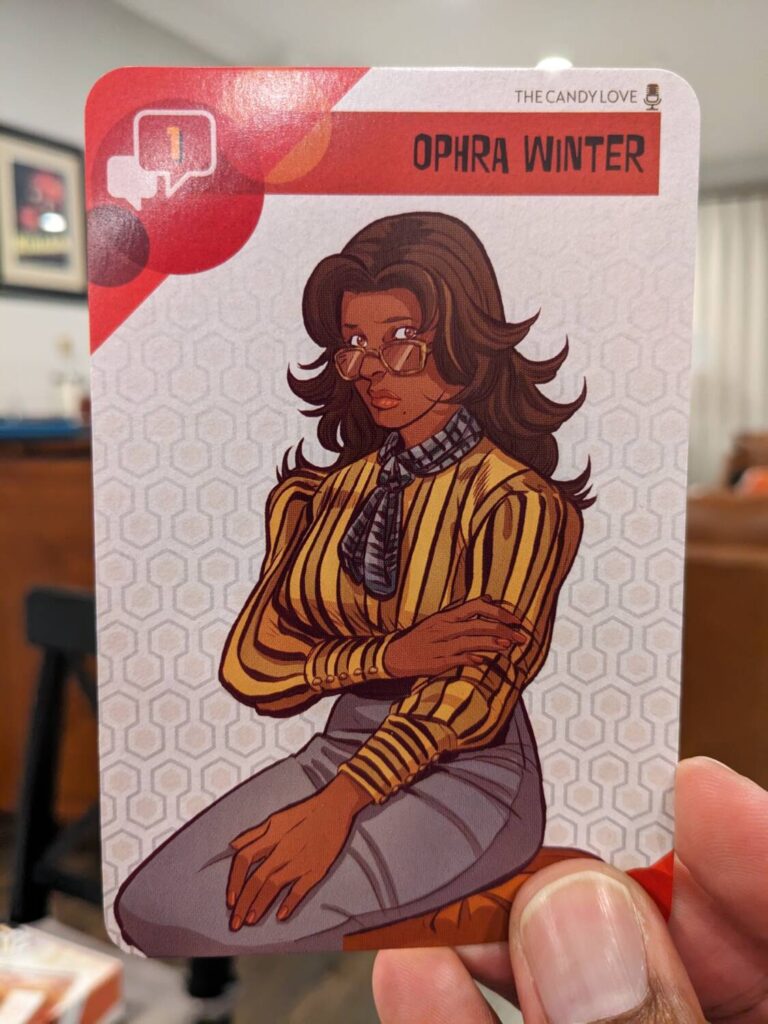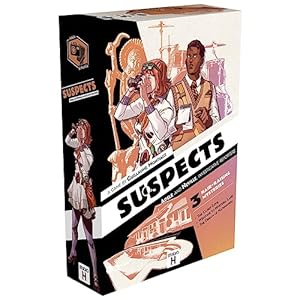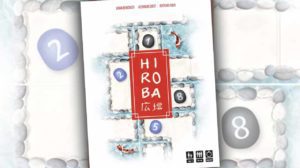Disclosure: Meeple Mountain received a free copy of this product in exchange for an honest, unbiased review. This review is not intended to be an endorsement.
Wine, music, Friday nights…game night with my wife is always good, and when we get the chance to work together on another single-play mystery game, it’s always the easiest sell of the week.
My wife and I had the chance to play the introductory scenario for the Suspects series, Suspects: The MacGuffin Affair, and really enjoyed the experience. That warm up took about an hour and introduced the format for these games—a deck of about 50 cards, separated into information about suspects, locations, and specific clue cards with a minor element of set collection added into the proceedings.
All the scenarios score the same way—points are scored based on how many cards players used to deduce the answers to a few questions posed during that scenario’s setup. The first three Suspects games featured investigator Claire Harper (The MacGuffin Affair, Claire Harper Takes the Stage, and Claire Harper, Eternal Investigator) over a long stretch of the early-to-mid 1900s, taking inspiration from some of the winding narratives of Agatha Christie novels
The newest game, Suspects: Adele and Neville, Investigative Reporters, takes players through three adventures set in the 1960s. Taking on the roles of Adele and Neville, a photojournalist and a writer who met at Columbia University, players will once again be forced to deduce the mysteries in the box with a deck of about 50 cards per scenario and a well-written introduction.
For more on how these games play, feel free to check out my review of the first game. I’ll share my spoiler-free thoughts on each of the three scenarios below.

“The Candy Love”
The “easy” mission in this box is a murder mystery set in 1962. A band’s recording session at a wealthy producer’s home one night goes late, then tragic—the producer ends up dead near the pool in his backyard, and it just so happens that Adele and Neville are on site when the dirty deed is done.
Let’s first talk about the difficulty for Adele and Neville: these cases are tough. The cases don’t have a direct path to solutions. Usually, players have to make a leap of faith at some point to figure out who is responsible for the crimes, the motivation of various individuals, and a few other items that are never spelled out in the cards. (More on that in a moment.)
In many ways, reading the solution for the cases in this package was pretty entertaining because I’m not sure I would have made some of the connections without a little help. In that way, The Candy Love is certainly the easiest case in the box, but it’s not a cakewalk. Parts of the story feel more predictable than others, and there are a few bits of information clearly included to throw players off the scent. There is a small set of suspects in The Candy Love so coming up with the “whodunit” is a little easier here. There’s a document that includes a fake album cover for The Candy Love (the name of the band, in this instance), with some cute names for the songs on that album.
As a production, The Candy Love is the best of what the Suspects games have to offer: accessibility. It took us most of the deck to come up with a solution, and we scored 13 points for our efforts, giving us the second-best ending. (All of the games here score the same way: if you use 25 cards or less to come up with the correct answers to any of the four questions in the setup, you earn five points; 26+ cards, four points; 35-40+ cards, three points (a range, based on the overall size of that case’s deck). Players score zero points for a wrong answer.)
For The Candy Love, we answered two of the four questions correctly within 25 cards, then got a third right after our 36th card and the fourth question wrong.
A few of the cards felt extraneous, and seemed to exist only to extend the number of cards needed to solve the case. Games of Suspects intentionally feature cards that are dead ends; some people love this, and others are, well, me. Still, this was a great warmup.

“Welcome to Mysteria Lane”
The story, and the solution, for Welcome to Mysteria Lane struck my wife and I as being utterly ridiculous.
That’s not because it didn’t make sense. It’s because it required a real stretch of the dramatic novel / bad TV mystery-drama show background we both share when it comes to trying to explain the shenanigans in this mystery.
In this scenario, the action takes place in 1964 and our investigative reporters are in the greater New York City area. A local salesman has been murdered, found dead floating in a neighbor’s pool. The salesman seemed to have everything, including a great wife, loyal friends, and a successful professional life. Until, you know.
My wife and I found ourselves 40 cards deep before we really felt like we could answer any of the questions definitively. There is a larger pool of suspects that need to be interviewed to work through Welcome to Mysteria Lane, with plenty of dead ends. One of the four questions in this case felt straightforward, and we got that one right in the end. But the rest of it was a hot mess.
A big part of the mystery in the second scenario is tied to elements surrounding an interesting question about why one of the characters was even in town in the first place. And the way the game explains this in the solution document—and let it be known, I LOVE the way the solution answers are laid out, along with the specific cards that call out the logic behind the “how”—is such a stretch that even the solution document admits that it is a stretch.
This case was the only time where it felt like some of the final solution was not knowable without having someone spoon feed the answers to players. My wife and I had a good laugh at how everything played out here, but it still didn’t feel…fair. Like, if you were really trying to high score this thing, and then you ended up with a six-point score like we did, you’re going to feel like you got hosed.
The logic pattern of the second scenario is the worst part. Even in a bad murder-mystery flick, the way things play out wouldn’t hold water with an audience. In an Agatha Christie novel, you get that sense of the motivations and you are reading to see how the author tries to piece everything together in a way that you didn’t see coming. Once you know the final answer, you can see how we got here.
Not so with Welcome to Mysteria Lane. I just wasn’t buying it. If you have the chance to play it, I have a feeling you will agree…it just doesn’t fit, which then made the hour we spent playing this one feel a bit empty.

“The Dream of Kathmandu”
The Candy Love was “easy” and Welcome to Mysteria Lane was listed as “moderate” in the game’s instruction manual. The Dream of Kathmandu is dialed up to “hard.” In our experience, The Dream of Kathmandu was not necessarily hard, because like Welcome to Mysteria Lane, it feels like a scenario that is more interesting after you’ve made your final guess only to find that you probably had no chance of knowing all the answers in detail until reading the solution sheet.
The main story of The Dream of Kathmandu concerns a number of shady characters in Nepal, 1969, and the death of one character that sounds a lot like a vision another character has the same night of the murder. There’s a hotel, drugs, a hit song, and plot twists that felt very familiar to my wife and I. Also, in a nod to the Exit game series (and this is recognized in the game’s instructions, so this is not a spoiler), the outer game box is used as an exhibit players will need to leverage to solve part of the mystery.
Those familiar plot twists? The plot is acknowledged in the solution as coming from a show that my wife and I both watched on Netflix. That made this case particularly fun for me, and knowing the show doesn’t necessarily mean that you’ll be better prepared to come up with a solution to the case in the game.
Like Welcome to Mysteria Lane, we scored six points because we got two of the game’s four major questions answered after reviewing most of the deck. We decided that we got one of them wrong even though…well, I can’t tell you why without spoiling part of the story. But, in keeping with the game’s overall difficulty, some of the solution answers come from being able to correctly determine how the crime was committed, and if you never see certain cards, you can’t know some of the facts.
After the frustration of Welcome to Mysteria Lane, we had a better time with The Dream of Kathmandu because we came into the final scenario just hoping to have fun with the narrative. Like all three of the scenarios in Adele and Neville, the writing is mostly excellent, and the various names for locations or some of the funnier exchanges between suspects and investigators really landed well in this final scenario.

The Verdict
Suspects: Adele and Neville, Investigative Reporters is a fun ride, even if those looking for a logic puzzle might be disappointed by the fact that some of the game’s plot twists are impossible to predict. The folks at Studio H and the game’s designer, Guillaume Montiage, do a great job of transporting players to a living mystery novel, where they will have more control over making decisions based on the evidence as it unfolds.
As a production, the Suspects games are excellent. Moving from card to card is so easy to navigate. I love how portable they are—you could throw a 50-card deck and the solution envelope in your backpack and knock out a game while sitting in an airport lounge, with 90 minutes’ worth of entertainment ready to go. The way cards play off of each other is great and the light set collection element of the clue cards makes hunting for the right ones a fun search.
My deduction brain was disappointed a few times when what looked like clear-cut evidence turned into a twist that I couldn’t see coming until we opened the solution envelope. But that’s what makes books by the world’s best detective writers so good—the twists that provide the best entertainment, even if those twists don’t always make sense. If you are looking for games with better logic puzzles, you have to stick with stuff like The Search for Planet X or Turing Machine.
Have you seen the movie Wild Things, the Matt Dillon murder-mystery flick from like 20 years ago? That film does something that most films haven’t tried—the movie shows you 6-7 scenes that take place between the events that happen in the main film, to sort of go back in time and tell you how the film addressed the logic behind the twists you discover during the film. In this way, it is actually impossible to know how everything happens while watching the movie, and the writers fill in those blanks after some surprises from the ending.
Adele and Neville, in a few ways, reminds me of Wild Things. Even if you go through all the cards in a given scenario, you’re still armed with only about 90% of the information…you still have to make a leap on your own. That will be for some gamers, and mostly, it is for me. Armed with this info, I’m excited to tackle Suspects: Claire Harper, Eternal Investigator, which arrived on my doorstep just as I finished the writeup for Adele and Neville. One-shot mystery games…I can’t get enough!












Add Comment